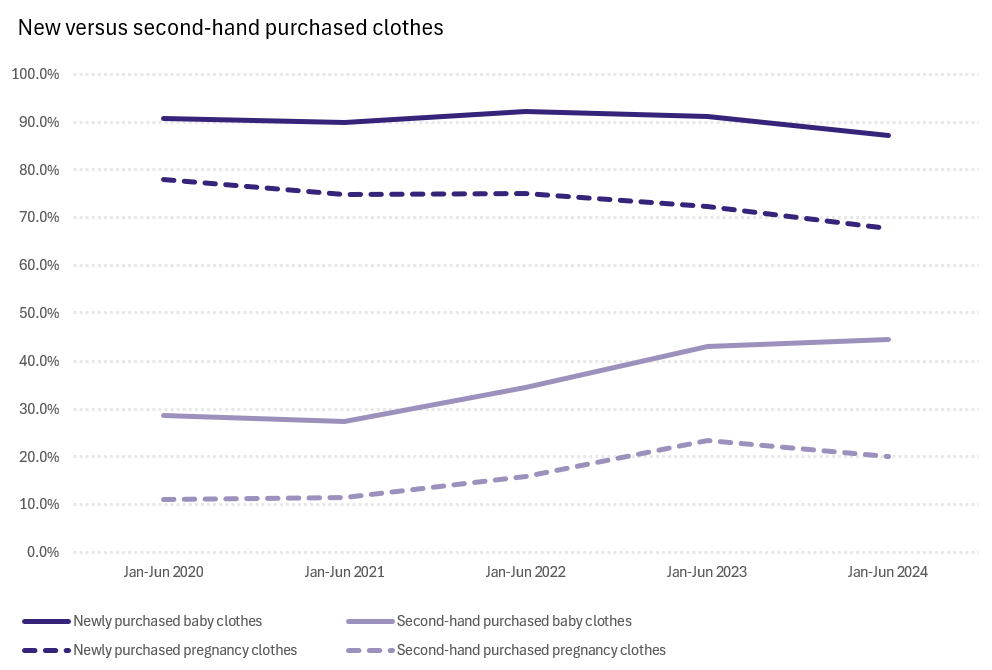News article
Is sustainability considered important when buying baby items?
Around us we hear more and more parents are shopping for secondhand baby items on various platforms. Clothes and other items are only needed for such a short time that it’s sustainable to reuse them. Is this actually reflected in the figures? We decided to dive into the WIJ Monitor studies from the past five years.
The champion of sustainability is baby clothes
Of all baby items, baby clothes are most often bought secondhand, borrowed, or given away. Especially in small sizes this makes sense, which only fit for a very short time. They are still nice enough for a second or third life. This is not only good for the environment, but also for the wallets of young parents.
We see new purchases decrease by about 3.5% over a period of five years. Secondhand, borrowed, and gifted clothing purchases increase by about 15%. Many parents in the study dress their babies in previously worn clothes. The percentage of parents buying new clothes is still over 87%. This means we can conclude that many babies have both new and second-hand clothes in their closets.
Maternity clothes are also frequently reused
Five years ago, over 78% of maternity clothes were purchased new; now that figure is 67.7%. Newly acquired clothing also decreased from 4.2% to 2.4%. However the increase in secondhand purchases, gifts, and borrowings isn’t spectacular: from 46.5% to 52.2%. Here we see something remarkable: more women aren’t wearing any special maternity clothes at all! That percentage actually increased from 6% to 11.2%. This is also sustainable: wearing your normal loose-fitting, stretchy clothes throughout the pregnancy.
Maternity clothes are also frequently reused.
Slightly less secondhand transport
We’re seeing a slight decrease in the percentage of secondhand items for both strollers and car seats. This includes items bought, received, and borrowed secondhand. For strollers, this percentage dropped by about four percent in five years to 25.2%. More strollers belong to older children (up two percent to 30.2%). For car seats, it’s important to ensure they haven’t been involved in a collision to ensure safety. The percentage of secondhand items decreased by 1.7% to 24.5%. Safety takes precedence over durability.
Preferred new: bottles and cutlery
Over the years, bottles are mainly purchased new (almost 87% according to the latest survey). This is almost unchanged compared to five years ago. Bowls and other cutlery are still used by older children, but babies still primarily use their own new items. It is most likely that the reason for this is that bottles and cutlery are used quite intensively and are therefore worn out. It is more hygienic to buy these new.
Striking: breast pumps are being rented more often
You might expect the same trend for breast pumps for hygiene reasons. But things are a bit different. We see an increase in all acquisition methods: bought new and received, bought and received secondhand, and also “still owned by an older child.” We can conclude that more mothers are using a breast pump than five years ago. The percentage of mothers renting a breast pump is striking: it increased from 5.4% to 12.4%. This means that the total number of secondhand use is increased from 23.7% to almost 35%.

About the WIJ Monitor
The WIJ Monitor is an ongoing study conducted by the data-driven media company WIJ Special Media. This study has been running since 2012 and maps the customer journey of (expectant) mothers as they purchase various baby products. WIJ Special Media has extensive knowledge of the baby market and regularly conducts various studies.
